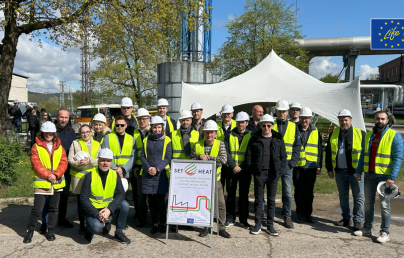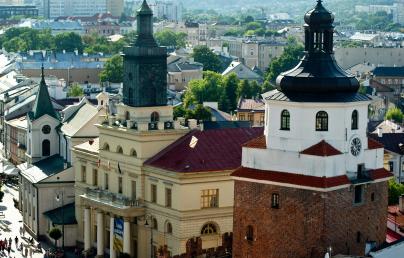
Sophie Dourlens-Quaranta: ‘By prioritising future-proof design principles, we empower building owners and operators to stay ahead of regulatory changes, emerging energy models, and evolving occupant needs with minimal disruption’

Sophie Dourlens-Quaranta: ‘By prioritising future-proof design principles, we empower building owners and operators to stay ahead of regulatory changes, emerging energy models, and evolving occupant needs with minimal disruption’
Building conversations up with... Sophie Dourlens-Quaranta, Managing Partner France at R2M Solution.
Background
Sophie holds a PhD in Mathematics and an Advanced Master's in Energy System Optimisation, with 20 years of experience in the energy sector. She began her career at the French Energy Regulator, specialising in cross-border market design for electricity and gas. She later joined the Nice Chamber of Commerce and Industry, where she played a key role in structuring the local energy cluster.
Since 2013, Sophie has been actively engaged in developing innovative solutions, working as a consultant, proposal writer and project manager across electricity transmission systems, energy markets, smart cities and smart buildings. She has also led multiple service contracts for the European Commission, supporting policy development in the energy sector. Currently, Sophie is a Managing Partner of the French branch of Research-to-Market (R2M) Solution, a multidisciplinary innovation and consulting firm dedicated to bridging the gap between research activities and market implementation.
BUILD UP (BUP): How do smart buildings contribute to energy efficiency and reduce operational costs over time?
Sophie Dourlens-Quaranta (SD-Q): Buildings account for a large share of Europe's energy consumption. While improving their energy efficiency through traditional methods—such as enhancing insulation or replacing inefficient heating systems with efficient, low-carbon alternatives— remains a priority, the Energy Performance of Buildings Directive (EPBD) also underscores the importance of digitalising building energy systems. Smart technologies can deliver energy savings of up to 30%, and these solutions do not necessarily require complex or costly implementations from the design phase. For example, installing smart thermostats in individual rooms and integrating occupancy-based lighting controls can achieve a return on investment (ROI) within two years. Additionally, smart scheduling of energy consumption—covering appliances, electric vehicles charging, and other energy-intensive systems—can further enhance efficiency. At R2M Solution, we provide innovative solutions that help buildings optimise their energy use with short payback periods. One such example is BrainBox AI, which leverages artificial intelligence (AI) and optimisation algorithms to proactively manage Heating, Ventilation and Air Conditioning (HVAC) systems in non-residential buildings, leading to energy savings of up to 25%.
BUP: How do smart building technologies influence occupant comfort, health, and productivity?
SD-Q: The benefits of smart building technologies extend beyond energy savings. Optimised scheduling of heating and cooling systems—particularly when integrated with external temperature sensors and weather forecasts—helps maintain stable indoor temperatures, enhancing comfort and, in non-residential buildings, boosting productivity. Summer comfort can be enhanced through the automated control of solar shading. Indoor environmental quality (IEQ), including air quality, is another critical factor that can be significantly improved thanks to intelligent ventilation systems or smart sensors, particularly when integrated with a comprehensive space management platform such as SPACETI.
'Optimised scheduling of heating and cooling systems helps maintain stable indoor temperatures,
enhancing comfort and, in non-residential buildings, boosting productivity'
Through our participation in EU-funded research projects such as EPC-RECAST, SMARTER EPC and EVELIXIA, R2M develops solutions that enhance both energy efficiency and occupant well-being. These efforts ensure that buildings are optimised not only for cost-effectiveness, but also for enhanced comfort and productivity. Such considerations are also reflected in building certification protocols such as LEED, WELL, and BREEAM. The WELL Building Standard, in particular, is a performance-based system designed to measure, certify and monitor building features that influence human health and well-being, focusing on air, water, nourishment, light, fitness, comfort, and mental well-being. As a registered Performance Testing Agent for WELL, R2M works directly with real-estate stakeholders who recognise the value of developing, managing, and offering buildings that excel in these areas.
BUP: What are the latest trends or innovations in smart building technology?
SD-Q: The 2024 revision of the EPBD plays a crucial role in advancing smart building innovation by mandating the use of the Smart Readiness Indicator (SRI) for large buildings and establishing conditions for digital building logbooks (DBLs). Consequently, key trends include the expanded assessment and adoption of smart building technologies, the digitalisation of assets, enhanced building performance reporting, and the development of training programs and registered assessors to address these evolving requirements.
From a technological viewpoint, smart building innovations are rapidly evolving, incorporating digital twins for real-time performance monitoring, cybersecure Internet of Things (IoT) sensors to optimise IEQ and comfort, and smart microgrids for transforming buildings into active energy prosumers. Edge computing enables instant decision-making, while adaptive facades respond dynamically to weather conditions for energy savings. Additionally, robotics can automate cleaning, security, and maintenance, making buildings more intelligent, resilient, and sustainable.
A key trend driven by R2M is the adoption of predictive maintenance decision support tools, such as KAIZIS, to optimise operations, reduce costs and extend equipment lifespan. These tools provide facility managers with structured data and actionable insights, enabling informed decisions on reconfiguring, repairing, or replacing equipment in response to irregularities, over-consumption, performance drift or malfunctions.
Another notable trend is the integration of energy models with real-time data. During the design or certification phase, stakeholders often invest heavily in developing dynamic energy simulation models. These models have substantial potential in a building’s operational phase, enabling real-time performance monitoring and optimisation.
BUP: How do these digital technologies integrate with other sustainability features of a building, such as renewable energy generation, passive cooling and heating systems, and heat pumps?
SD-Q: Building energy use is increasingly shifting towards electrification. For instance, fossil fuel boilers are gradually being replaced by heat pumps and other renewable energy solutions, as demonstrated in the SEEDS project. Simultaneously, electricity production is becoming more decentralised and non-dispatchable, driven by the expansion of solar photovoltaics (PV), particularly at the building level. The combination of these two trends underpins the need for flexibility markets to help system operators balance electricity supply and demand in real time in a cost-effective manner. Smart technologies enable buildings to contribute to these markets by offering flexibility services, such as HVAC systems that adjust in response to grid signals. The SRI, introduced by the EPBD to assess a building’s capacity to leverage smart technologies, recognises energy flexibility—the ability to adapt to grid signals—as a core functionality of smart buildings. Additionally, initiatives like GOFLEX in France provide quantitative assessments of a building’s flexibility potential, expressed in kilowatts (kW).
'The SRI recognises energy flexibility —the ability to adapt to grid signals—as a core functionality of smart buildings'
BUP: How do you ensure that smart building systems remain adaptable to future technologies?
SD-Q: Ensuring the longevity and adaptability of smart buildings requires a combination of interoperability, modularity, and open standards. As buildings evolve, emerging technologies—such as AI-driven optimisation, decentralised energy systems, and IoT-based automation—must be both economically viable and seamlessly integrated with existing infrastructure. Interoperability is crucial; smart building systems should support open communication protocols like BACnet, KNX or MQTT to prevent vendor lock-in and facilitate future upgrades without major overhauls. Modularity enables the integration of new hardware and software components as needed, ensuring flexibility in system expansion. Plug-and-play capabilities, such as those found in software-defined building management systems, allow for effortless adaptation to innovations like digital twins, blockchain-based energy transactions, and next-generation occupancy sensors. By prioritising future-proof design principles, we empower building owners and operators to stay ahead of regulatory changes, emerging energy models, and evolving occupant needs with minimal disruption.
BUP: Are there some European or national projects that could be highlighted to illustrate the integration of smart building technologies in the European building stock?
SD-Q: There are numerous initiatives driving smart building innovation across Europe. The SmartBuilt4EU coordination and support action compiled EU-funded projects in its Smart Buildings EU-funded Innovations brochure, showcasing projects that have advanced smart building technologies up to 2023. These projects were categorised based on the SRI aspects they address, including energy efficiency, maintenance and fault prediction, comfort, convenience, health, well-being and accessibility, information to occupants, and energy flexibility. More recently, projects such as EVELIXIA and WeForming have been pushing the boundaries of technological advancements in the sector.
In parallel with these technology-driven projects, policy support initiatives co-funded by the LIFE programme have been launched to enhance the overall smart readiness of European buildings. These initiatives directly assist Member States in testing the SRI, paving the way for its implementation by 2027, as outlined in the EPBD. Additionally, the SUSTAIN project, funded under the European Union’s Joint Cluster Initiatives (Euroclusters), facilitates SME participation in developing and testing SRI-integrated smart building solutions. R2M is a partner in three projects funded under this initiative: PREMISES, which focuses on AI-powered predictive maintenance; SCAN2SRI, which develops SRI-enabled, 3D immersive navigable models; and SRICOMPASS, which explores the integration of Building Information Modelling (BIM) with SRI assessments.

